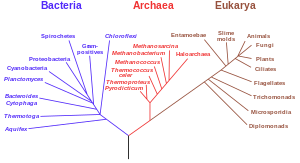Three-domain system
It has been suggested that this article be merged into Domain (biology). (Discuss) Proposed since January 2009. |
This article needs additional citations for verification. (June 2007) |

The three-domain system is a biological classification introduced by Carl Woese in 1990[1] that divides cellular life forms into archaea, bacteria, and eukaryote domains. In particular, it emphasizes the separation of prokaryotes into two groups, originally called Eubacteria (now Bacteria) and Archaebacteria (now Archaea). Woese argued that, on the basis of differences in 16S rRNA genes, these two groups and the eukaryotes each arose separately from an ancestor with poorly developed genetic machinery, often called a progenote. To reflect these primary lines of descent, he treated each as a domain, divided into several different kingdoms.
Classification
Niches
Each of the three cell types tends to fit into recurring specialties or roles. Bacteria tend to be the most prolific reproducers, at least in moderate environments. Archaeans tend to adapt quickly to extreme environments, such as high temperatures, high acids, high sulfur, etc. This includes adapting to use a wide variety of food sources. Eukaryotes are the most flexible with regard to forming cooperative colonies, such as in multi-cellular organisms, including humans. In fact, the structure of a Eukaryote is likely to have derived from a joining of different cell types, forming organelles.
See also
References
- ^ Woese C, Kandler O, Wheelis M (1990). "Towards a natural system of organisms: proposal for the domains Archaea, Bacteria, and Eucarya". Proc Natl Acad Sci USA. 87 (12): 4576–9. doi:10.1073/pnas.87.12.4576. PMID 2112744.
{{cite journal}}: CS1 maint: multiple names: authors list (link)
